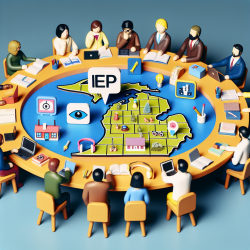Introduction
The integration of Health Information Technology (HIT) into Medicaid services presents a myriad of legal challenges and opportunities. As practitioners, understanding these legal frameworks can enhance our ability to deliver quality care, especially in fields like speech-language pathology where data-driven decision-making is paramount. This blog explores the findings from the research article "Medicaid and Health Information: Current and Emerging Legal Issues" and how these insights can be applied to improve practitioner skills.
The Importance of HIT in Medicaid
Medicaid, as the largest federal health care program, serves a diverse population, including children and adults with chronic conditions. HIT is crucial for improving care quality and reducing disparities. However, the adoption of HIT in Medicaid has been slow, with spending on technology being less than 1% of the total program expenditure in 2005. This underinvestment poses a risk of exclusion from technological advancements that could significantly enhance care delivery.
Legal Barriers and Opportunities
The research highlights several legal questions that need addressing to facilitate HIT integration:
- Fiduciary Duty: Medicaid's fiduciary duty requires state programs to act in beneficiaries' best interests, which includes adopting technologies that improve care quality and safety.
- Privacy Standards: Aligning Medicaid privacy standards with the Health Insurance Portability and Accountability Act (HIPAA) is crucial for seamless data sharing and interoperability.
- Interoperability: Legal barriers must be addressed to ensure Medicaid data can interact with other health, educational, and social programs.
Implications for Practitioners
For speech-language pathologists and other practitioners, understanding these legal frameworks can enhance service delivery. Here are some practical steps:
- Advocate for HIT Adoption: Encourage your organization to invest in HIT systems that align with legal standards, improving data accuracy and patient outcomes.
- Stay Informed: Keep abreast of legal changes in Medicaid and HIT to ensure compliance and leverage new technologies effectively.
- Enhance Data Security: Implement robust data security measures to protect patient information, in line with both Medicaid and HIPAA standards.
Encouraging Further Research
Practitioners are encouraged to delve deeper into the legal aspects of HIT in Medicaid. Understanding these complexities can empower you to advocate for necessary changes and improvements in your practice. Engaging with ongoing research and policy discussions can also provide valuable insights into future trends and challenges.
Conclusion
The integration of HIT into Medicaid services is not just a technological challenge but a legal one. By understanding and addressing these legal issues, practitioners can play a pivotal role in enhancing care quality and outcomes for Medicaid beneficiaries. For a comprehensive understanding of these legal frameworks, practitioners are encouraged to read the original research paper.
To read the original research paper, please follow this link: Medicaid and Health Information: Current and Emerging Legal Issues.










